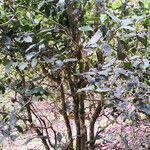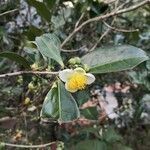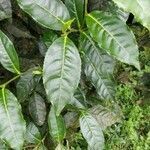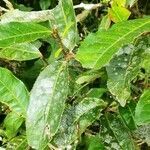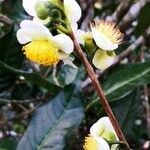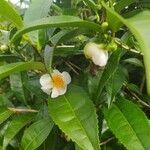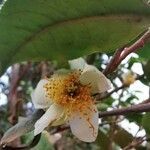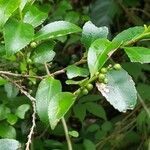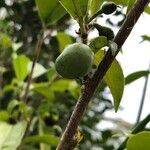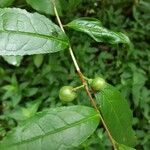Shrubs or trees, 1-5(-9) m tall. Young branches grayish yellow, glabrous; current year branchlets purplish red, white pubescent; terminal buds silvery gray sericeous. Petiole 4-7 mm, pubescent, glabrescent; leaf blade elliptic, oblong-elliptic, or oblong, 5-14 × 2-7.5 cm, leathery, abaxially pale green and glabrous or pubescent, adaxially dark green, shiny, and glabrous, midvein ± raised on both surfaces, secondary veins 7-9 on each side of midvein and ± raised on both surfaces, reticulate veins visible on both surfaces, base cuneate to broadly cuneate, margin serrate to serrulate, apex bluntly acute to acuminate and with an obtuse tip. Flowers axillary, solitary or to 3 in a cluster, 2.5-3.5 cm in diam. Pedicel 5-10 mm, recurved, pubescent or glabrous, thickened toward apex; bracteoles 2, caducous, ovate, ca. 2 mm. Sepals 5, persistent, broadly ovate to suborbicular, 3-5 mm, outside glabrous or white pubescent, inside white sericeous, margin ciliolate. Petals 6-8, white; outer 1-3 petals sepaloid; inner petals obovate to broadly obovate, 1.5-2 × 1.2-2 cm, basally connate, apex rounded. Stamens numerous, 0.8-1.3 cm, glabrous; outer filament whorl basally connate for ca. 2 mm. Ovary globose, densely white pubescent, tomentose, or subglabrous, 3-loculed; style ca. 1 cm, glabrous or base pubescent, apically 3-lobed. Capsule oblate, 2-coccal, or rarely globose, 1-1.5 × 1.5-3 cm, 1-or 2-loculed with 1 seed per locule; pericarp ca. l mm thick. Seeds brown subglobose, 1-1.4 cm in diam. Fl. Oct-Feb, fr. Aug-Oct.
An evergreen tree. It grows to a height of 10-15 m and spreads 4 m across. Trees are normally pruned into bushes. The stem is slender. The bark is yellowish grey. It has a strong taproot and side roots just under the soil. The leaves are dark green and glossy. They are elongated and leathery. They can be 5-30 cm long. The leaves taper towards the base and the tip. The edges of the leaves have fine teeth along them. The leaf stalks are short. The flowers are white and small. They can occur either singly or in broad flat clusters. The fruit is a woody capsule. It can be 1.5 cm across. There are over 350 named cultivated varieties.
